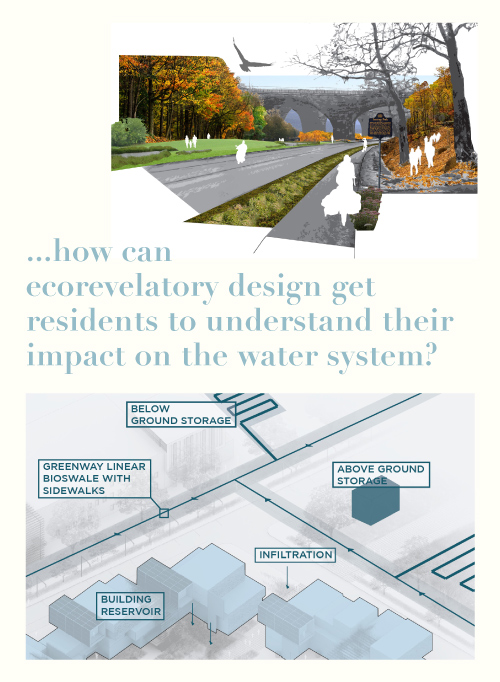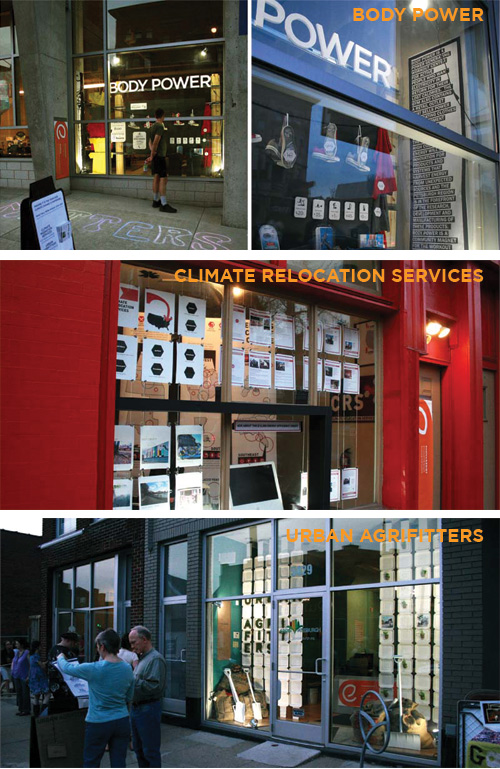Urban Strategies: Design for Engagement
Have you ever seen a familiar place that has been transformed through the lens of a Hollywood film? A few years ago, a Bruce Willis production filmed some of my favorite urban places and reconstructed them in a way that changed how I saw relationships between the neighborhoods of my fair city. Once I looked past the painful dialogue and predictable action scenes, the movie presented a city where one could live and travel on the rivers. The movie sequences allowed me to imagine the city that had been designed to make our forgotten rivers into a fantastical outdoor room.
Design has the power to change how we understand and relate to our environment. The places we create, the processes we define, and the actions we take are all acts of design where we engage our environment in new ways. We wanted to know how design could be used to help us rethink and reimagine something that may seem so far from our current reality—ecologically friendly communities.
Let’s look at one area of great concern, the crisis of our urban water systems. One legacy of our industrial development is the degradation of ecological systems. After centuries of sewage in backyards and on urban streets, the giant sewage systems that whisked waste away seemed like a modern miracle and improved health and well being. Rainwater was not a resource but a liability and it was also drained rapidly. Today we are left with a combined sewer system that is in desperate need of maintenance and will require extraordinary costs to fix. With each advance in technology and infrastructure improvement, we created longer feedback loops and lost the connection between our actions and the consequences of our actions.
Design for engagement is a principle that reconnects action and consequence by making ecological patterns visible once again. Ecodistrict technologies such as onsite rainwater management and decentralized sewage treatment require a more informed, if not more active, citizenry to manage and maintain them. Celebrating water systems through design of our houses, blocks and neighborhoods is a first step in understanding the dynamics of water. Defined as “ecorevelatory design,” or design that reveals the ecology of a place, this once peripheral concept has moved to mainstream design, with unlikely building types such as skyscrapers now actively responding to forces like wind and sun.
Design that engages and reveals is core to our work. In our Living City Challenge Masterplan for the Larimer neighborhood, we designed water collection systems that integrate into the transportation infrastructure and proposed wonderfully engaging spaces that also supported a multilayered food and waste nutrient cycling system. The design of compelling experiences is a powerful way to engage people with their place and to connect them to the dynamics of the flows of energy, water, and nutrients.
While the focus of design is often on the artifact, we believe that the design of systems of interaction can be another powerful way to engage a community. Ezio Manzini’s Scenarios series and SlowLab experiments are an inspirational way of rethinking economic and social engagements for environmental benefit. By focusing on the ways we organize our lives, we can design better ways to move materials, goods and services and create mutually advantageous economies.
Making systems of interaction visible can be even more challenging than revealing ecological systems and media like videos or installations can more effectively demonstrate interactions. When we rethought the traditional systems of exchange for our Penn Green project, we wanted to prototype ideas in real time; we populated three empty storefronts in our neighborhood with faux businesses that could exist if we rethought our commercial interactions. Urban Agrifitters was a supplier of material but also a source of knowledge for a robust urban farming community. Body Power was a gym where users could make money by working out on equipment that generated its own electricity. Climate Relocation Services was a hybrid sustainability and real estate office that catered to climate change migrants moving to the moisture-rich Pittsburgh region.
Penn Green – Installations provide a moment of interaction and realization
Design is the intention that redefines how we relate to each other and our environment. The process of designing places and artifacts are opportunities to reimagine a new relationship with our environment, especially when it seems remote or difficult to create. Design that reveals hidden systems, whether ecological or economic, is a powerful way to meet the challenges of ecologically benign communities.



